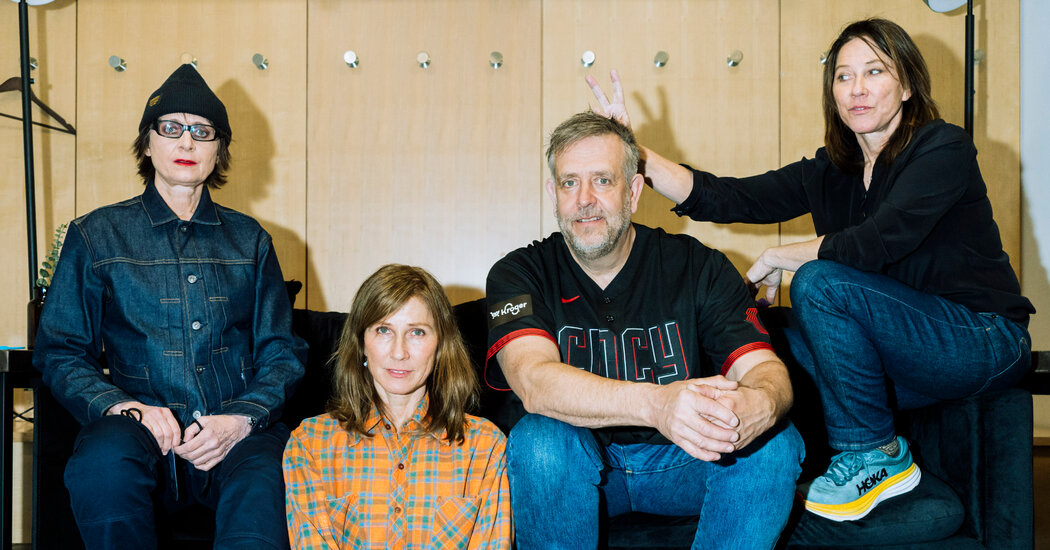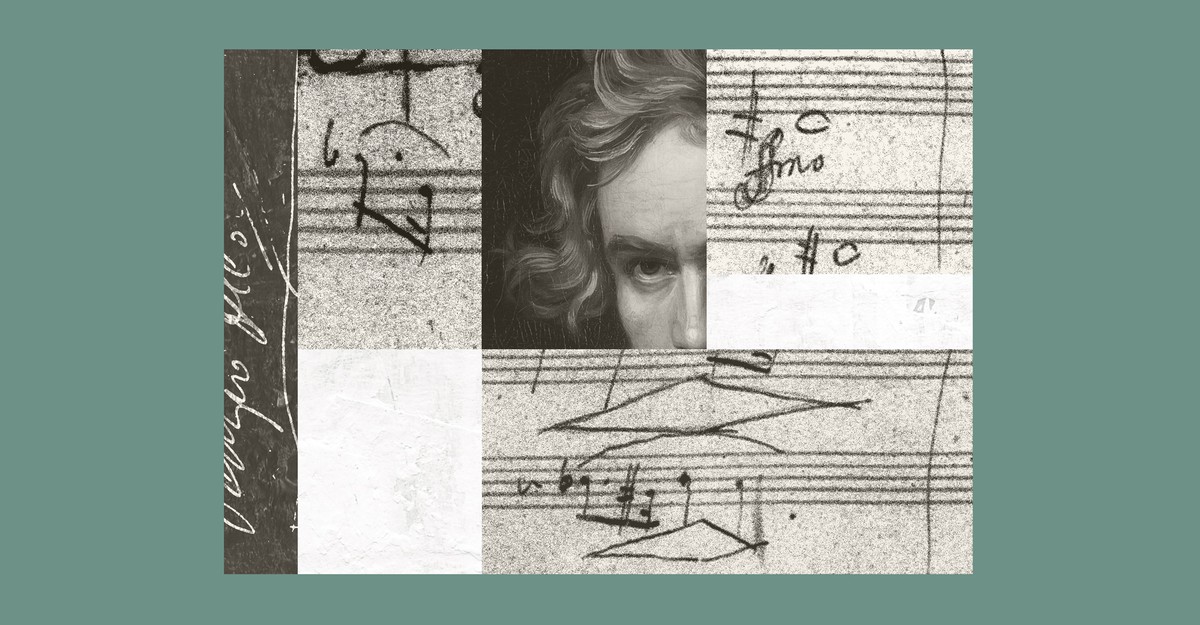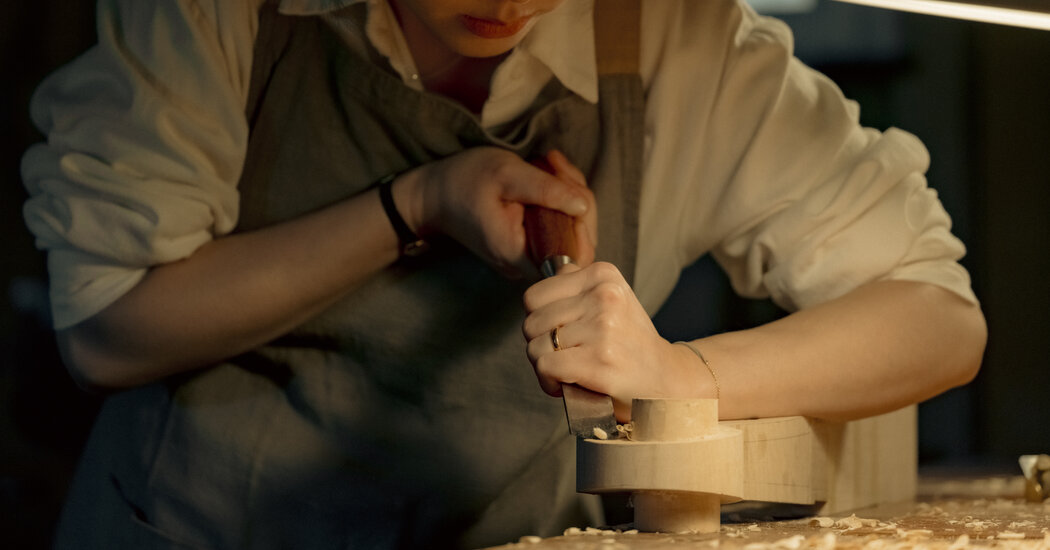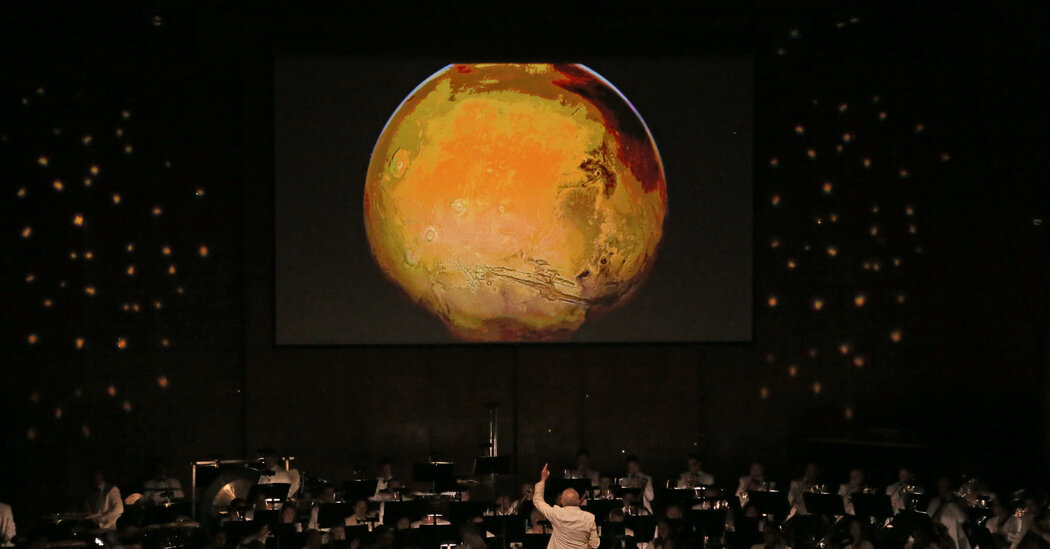‘They said I was worse than the Sex Pistols!’: folk legend Linda Thompson on trashing dressing rooms and losing her voice | Linda Thompson
[ad_1]
The photo on the front of Linda Thompson’s new album, Proxy Music, is nothing if not striking. It features Thompson posing in an identical outfit to that worn by the model Kari-Ann Moller on the cover of Roxy Music’s eponymous 1972 debut, although her expression is noticeably different: in place of Moller’s smouldering look to camera, Thompson offers a faintly disturbing grimace. She looks a bit nuts. “Yes,” she nods. “The photographer kept saying: ‘Do that thing that she does’ and I couldn’t. I’d had some banana cake, and I think I was having some kind of sugar rush. I think it’s hilarious. The original cover is so daft, I just thought I’d make it worse.”
It goes without saying that this all runs very contrary to the image of Thompson forged in the 1970s, when she made a string of incredible albums with her then-husband, Richard Thompson. There was something rather stern and austere about the Thompsons even before they gave away all their money and possessions and retreated to a Sufi commune. Their exquisite music was vastly potentiated by Thompson’s voice, a hugely affecting cocktail of fragility and toughness. On their most famous album, 1974’s I Want to See the Bright Lights Tonight, she sang like someone who had been horribly wounded by life but resolved to carry on anyway. Their releases were no one’s idea of a barrel of laughs.
Even their love songs were oddly sombre, while the sheer bleakness of Withered and Died or The End of the Rainbow can take your breath away. The most famous footage of them comes from The Old Grey Whistle Test in 1975, performing the impossibly beautiful A Heart Needs a Home. They sing with eyes closed and somehow look as if they’re freezing to death, him in a ratty woolly hat and her in a headscarf and polo neck: no fans of glittery postmodern glam they. “No, I didn’t listen to Roxy Music at the time,” Thompson confirms. “I was probably listening to Bulgarian folk music. We took ourselves very seriously. We’d read Blavatsky and Gurdjieff – all those terrible old charlatans, but we believed the whole thing. Oh my God, and the Tibetan Book of the Dead … it was Pseuds Corner all the way. And Richard wrote the songs and he had quite a bleak outlook, you know. He’s not a barrel of laughs today.” She chuckles. “I’m kidding. We took things a bit seriously and now I can’t take any of this seriously.”
Indeed, if the image on the cover of Proxy Music is a little hard to square with the Linda Thompson of old, so is the 76-year-old currently plying me with tea, cakes, pastries and sandwiches – she really has laid on quite a spread – in her west London apartment. She is tiny, clad in a Louis Vuitton jumper (“a fake, from China, 15 bucks”) and very funny. Her voice is thin and husky and her grandson Zack is on hand in case it gives out altogether. She rarely gives interviews as a result of the spasmodic dysphonia that has plagued her since the early 70s, gradually robbing her of her singing voice. “I was 25,” she says. “I’d go for my mouth and nothing would come out. It started when I was pregnant with my eldest daughter, and I just put it down to the pregnancy, but it wasn’t a happy time in my life. I think my then-husband wasn’t that keen on having a baby, blah blah blah, it was a difficult time, which we got through, but I think it impacted on me a bit.”
Dysphonia can be a trauma response, she explains, but “once that trauma’s happened you can’t mediate it away. At first it was more in my speech, then my singing. Onstage, people would go: ‘You’re off-mic!’, but I wasn’t – nothing was coming out. It’s like a switch just goes off in your brain: you know you’re doing it, but you can’t stop. If I’m alone, I can speak OK, but if anybody’s in the room, I can’t. And it’s a progressive condition, there’s no cure. I could lose my voice entirely, but the progression is very slow and” – she laughs again – “I doubt I’ll live that long anyway.”
In the past, Botox injections in Thompson’s vocal cords have enabled her to sing long enough to complete albums – her last was 2013’s Won’t Be Long Now – and, very occasionally, perform live. On Proxy Music, however, Thompson commissioned other artists to work on her new songs: the Proclaimers, the Unthanks, Rufus Wainwright. John Grant finds himself singing a track called John Grant about Thompson’s love of his work. It works wonderfully, heavily underlining Thompson’s skill as a sharp, witty and occasionally heartbreaking lyricist, as on I Used to Be So Pretty, which takes a very dim view indeed of ageing. “Oh, it’s just scary, being this age – it’s the age you die, when all your friends are dying,” she nods. “I mean, you don’t give a fuck what people think about you any more, and that’s good, but the wisdom-of-age thing is fallacious. You just get stupider, you can’t remember anybody’s name. So that’s a complete crock.”
Meanwhile, Those Damn Roches ruminates on musical families, including the one of which Thompson is the matriarch: Proxy Music features contributions from her ex-husband, her son, daughter, son-in-law and grandson, but the song avers that the Thompsons “can’t get along unless they’re apart”.
“That’s what families are like, isn’t it?” she says. “We don’t spend hours and hours together at Christmas, we have a meal and everyone goes: ‘Bye!’ Nobody likes to hang around. I toured with the family once,” she shudders. “Never again. Too fraught. You can’t tell your kids and your grandkids they’re playing the wrong chord. But there are funny times as well, and I do like what they do.
“Plus,” she adds, “they’re free.”
The album also takes Thompson back to her earliest musical memories: Wainwright croons his way through Darling, This Will Never Do, a fabulous slice of pre-rock’n’roll pop. That was what her parents played when she was growing up in Glasgow, she says, along with folk and country. “There was nothing to rebel against, with my parents’ taste in music. They liked Hank Williams – you can’t rebel against him. They liked the Everly Brothers’ country records – nothing to rebel against, the best voices I’ve ever heard. Then Bob Dylan appeared and they liked him too.”
She says she loved rock’n’roll, but was particularly drawn to folk “after Elvis went into the army and rock’n’roll went tits up. God knows why, but it reached out to me. The Scottish airs and reels were part of my childhood, they were very plaintive, heartstruck. I loved murder ballads, although there’s more of those in English folk than Scotland.”
She haunted Glasgow’s folk clubs with her friend John Martyn before they both relocated to London: he to record his debut album, 1967’s London Conversation, she to study history. She lasted a matter of weeks. “My mum had made me go to school until I was 18 years old and now nobody did. I was out till 2am singing at folk clubs so I couldn’t get up for lectures.”
Instead, she was drawn into a group of young musicians that circled the Troubadour club on Brompton Road: a group almost preposterously overstaffed with talent. She shared a flat with Tim Buckley and became best friends with Fairport Convention’s new singer, Sandy Denny. She had a brief and fruitless relationship with Nick Drake, who she once suggested was “probably gay, but couldn’t deal with it … it was hellish for gay people then”. One incredible album after another seemed to tumble from the group – Fairport Convention’s Unhalfbricking and Liege and Leif, John Martyn’s Bless the Weather and Solid Air, Nick Drake’s Five Leaves Left and Bryter Layter, and, after she married Fairport Convention’s former guitarist, Richard Thompson, their own trio of masterpieces: I Want to See the Bright Lights Tonight, Hokey Pokey and Pour Down Like Silver. “It was insane – we’d all be sitting in a room playing cards, everyone taking a turn at playing a song: Nick, John, Sandy, Richard, me,” Thompson recalls. “In fact, when Richard and I split up and I got to work with other people, it was much easier, because they weren’t of that level, they were just very good. I just took it as read that everyone was that talented.”
But it’s hard not to notice that, by the late 70s, Buckley and Drake were both dead from overdoses – heroin and antidepressants, respectively – and Denny from a fall down the stairs after years of alcoholism. Martyn had become an alcoholic, too, a violent one: his ex-wife Beverley’s account of their life makes for harrowing reading.
The thing was, says Thompson, it was an era before rehab and interventions. “It was hard to talk to Nick at the best of times, never mind give him advice,” she says. “Some of the most talented and savvy people I’ve known were riddled with insecurities. Sandy never felt pretty enough or whatever. Everybody wanted to be six stone and look like Twiggy and it’s not doable: I know; I tried. And these were very sexist times. She was in a man’s world so she drank and presented a front. In those days, if Sandy and I were in the studio and there was a tea break, there was no question it would be us making the tea. Some idiot playing a nose harp would just sit there: ‘Two sugars, love.’ We were tough, but we crumbled.”
Neither I Want to See the Bright Lights Tonight nor its follow-ups sold – Thompson says she made more money singing jingles for commercials – and her husband’s increasing interest in Islam eventually led him to move his family into a Sufi community. “It was in Norfolk, a big house that looked like the Bates motel in Psycho. It was fucking torture. Not for the men. We were kept in the kitchen, it was just kind of keeping women down. We weren’t allowed to go shopping because you weren’t allowed to look a man in the eye. Richard wasn’t allowed to do music – for some reason our cheikh, our leader, said men weren’t supposed to sing – but I had to sing at all these dos, for Eid or whatever, for hours and hours.
“I would say to Cheikh: ‘My throat hurts’ and he’d say: ‘Nonsense, you don’t sing from the throat, you sing from the stomach, keep singing.’ I think at the time I just accepted this purgatory as something I must have deserved. Like a lot of white, over-educated people, we were looking for something, and you think: ‘This must be it’ – through pain, you might get there. And I’d just had a baby, so I wasn’t quite in my right mind. There was no postnatal depression in those days, nobody had heard of it. People just told you to pull yourself together.”
The Thompsons eventually left the commune, but you could tell their marriage was in trouble just from the track titles of 1982’s Shoot Out the Lights: Don’t Renege on Our Love, Walking on a Wire, Did She Jump or Was She Pushed? Ironically, the album that documented their demise turned out to be their biggest seller, particularly in the US. Despite the fact that they had separated before its release, they were invited to tour America together: a terrible idea in theory, which turned out to be even worse in practice. “Everyone told me not to go: you’ve just had another baby, you’re out of your mind, you’re drinking, you’re taking pills,” says Thompson. “So I thought: ‘I’m going to do it.’”
The irony, she says, is that her dysphonia never bothered her – “I liken it to someone dropping an anvil on your foot and you forget about your headache” – although the backing musicians quickly started calling it the tour from hell. Existing largely on a diet of vodka and antidepressants, Thompson wasn’t above physically attacking her ex-husband onstage. “And I stole an audience member’s car in Niagra Falls and ended up in jail, but they didn’t press charges. They thought: ‘This woman is clearly deranged.’ I trashed one dressing room and the guy who put on the show said: ‘We had the Sex Pistols play here and you’re worse!’ I thought: that’s fabulous – can you say that again? It was like a delayed adolescence, because I’d been in this restricted, awful misogynistic group of people and this was my rebellion.”
She ended the tour being rescued by Linda Ronstadt, who found her comatose on the pavement outside the Whisky a Go-Go in LA. “Yes, at my own gig!” she says. “That was Al Stewart’s fault, he brought three bottles of champagne backstage as a gift and I think I drank them all before I went onstage. Linda took me home and sort of nursed me back to health. I went back to Britain, stopped drinking, stopped taking drugs. My mother had been looking after my kids, so I stopped everything and got on with it.”
She remarried and made a solitary solo album, 1985’s glossy One Clear Moment, before dysphonia took over. “I just kept telling myself: look, it’s not cancer, it’s not something happening to my kids. I thought: it’s a loss to me, it’s not a great loss to the world.”
Hang on, I think it’s a great loss, I tell her: you had an incredible voice.
She snorts. “Don’t forget to cash that cheque I sent you.”
Of course, it isn’t just me that thinks that – the handful of albums she managed to make in the 21st century were all rapturously received. Even Thompson will allow that “the records of Richard’s that people seem to esteem the most are the ones I was on, so I must have had something going”. Proxy Music is a triumph, even if it’s one she doesn’t have any plans to follow up.
“Oh no. I’m not making any plans. Even when I was young, there was no career plan: you couldn’t make a career plan with folk music. There was no point, you wouldn’t get very far, would you? And as I creep towards 80, my plans mostly involve remaining continent. I mean, I don’t think much ahead of the next sausage roll” – she looks at the plates on the table – “which I notice you haven’t eaten. Please, take a slice. And would you like another cup of tea?”
[ad_2]
Source link






